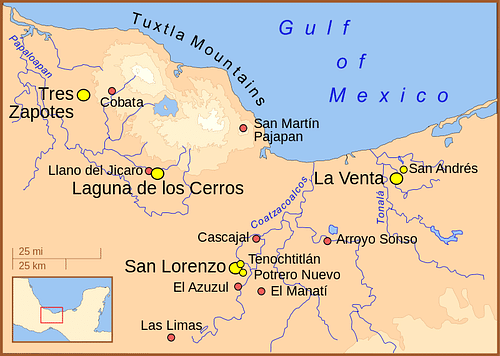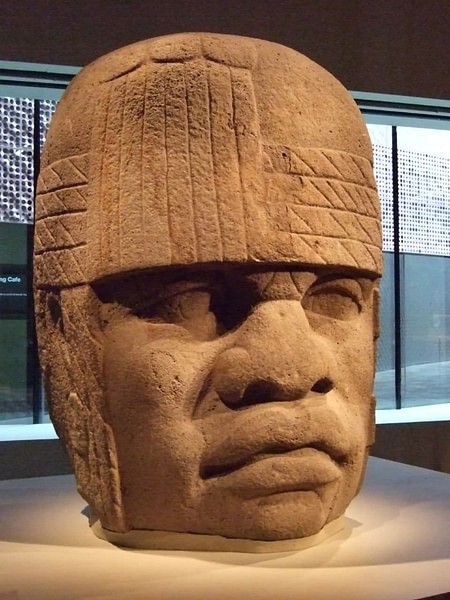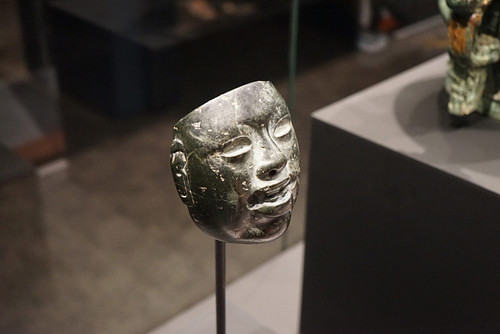What Do Art Historians Call Olmec Carved and Polished Axshaped Forms?
The Olmec civilisation, located in ancient Mexico, prospered in Pre-Classical (Determinative) Mesoamerica from c. 1200 BCE to c. 400 BCE. Monumental sacred complexes, massive stone sculptures, brawl games, the drinking of chocolate, and animal gods were all features of Olmec culture passed on to those peoples who followed this first slap-up Mesoamerican civilisation.
With their heartlands in the Gulf of United mexican states (now the states of Veracruz and Tabasco), Olmec influence and trade action spread from 1200 BCE, even reaching equally far south as present-day Nicaragua. Many Olmec sites suffered systematic and deliberate destruction of their monuments sometime between 400 and 300 BCE.
The Olmec Enigma
The Olmec civilization presents something of a mystery, indeed, nosotros exercise not even know what they called themselves, as Olmec was their Aztec proper noun and meant 'rubber people'. Due to a lack of archaeological prove their ethnic origins and the location and extent of many of their settlements are not known. The Olmecs did, still, codify and tape their gods and religious practices using symbols. The precise significance of this record is much debated but, at the very least, its complexity does advise some sort of organised organized religion involving a priesthood. The Olmec religious practices of sacrifice, cave rituals, pilgrimages, offerings, ball-courts, pyramids and a seeming awe of mirrors, was also passed on to all subsequent civilizations in Mesoamerica until the Spanish Conquest in the 16th century CE.
Around 900 BCE La Venta flourished as the new capital & eventually boasted a population of effectually 18,000.
Olmec Cities
Olmec prosperity was initially based on exploiting the fertile and well-watered coastal areas of the Gulf of United mexican states to abound such crops equally corn and beans (often twice-yearly) which allowed for an agricultural surplus. They likewise, no doubtfulness, gathered the plentiful local supply of establish food, palm nuts and ocean-life, including turtles and clams. By c. 1200 BCE significant urban centres developed at San Lorenzo (the primeval), La Venta, Laguna de los Cerros, Tres Zapotes and Las Limas. San Lorenzo reached its pinnacle of prosperity and influence betwixt 1200 and 900 BCE when its strategic position safety from flooding allowed it to control local trade. Typical Olmec trade appurtenances included obsidian, jade, serpentine, mica, rubber, pottery, feathers and polished mirrors of ilmenite and magnetite.

Main Olmec Settlements
Evidence of San Lorenzo's high civilization includes the presence of mound structures, perchance an early on ball court, carved basalt drains through one of the human-made mounds and the Crimson Palace structure with painted cerise floors and workshops. Around 900 BCE the site of San Lorenzo displays evidence of systematic destruction whilst La Venta, conversely, began to flourish, and becoming the new capital, it eventually supported a population of some xviii,000.
The iii sites of San Lorenzo, La Venta and Laguna de los Cerros all had a bilateral symmetry in their planning and at La Venta the first pyramid in Mesoamerica was constructed. It is the pre-meditated architectural layout of the religious centres of these settlements that is most striking, for example, at La Venta the buildings are placed symmetrically along a north-south axis with four colossal heads facing outwards at key points, seemingly acting as guardians to the complex. A huge ceremonial step pyramid (now a shapeless mound), sunken plaza one time lined with 2-metre high basalt columns, and two smaller pyramids/mounds provide features that would be copied time and over again at the major sites of later on Mesoamerican cultures with whom equal attending was paid to the precise alignment of buildings. La Venta, as with San Lorenzo, suffered systematic and deliberate devastation of its monuments sometime between 400 and 300 BCE.

Olmec Jumbo Head
Religious Beliefs
Every bit with other areas of Olmec civilisation, details of their faith are sketchy. Nevertheless, with an ever-increasing body of archaeological evidence it is possible to piece together some of the well-nigh important features of Olmec religion. The Olmecs seem to take had a particular reverence for natural places which connected with the of import junctions of heaven, earth and the underworld. For example, caves could lead to the underworld and mountains which had both springs and caves could offer access to all three planes. Of import Olmec mountain sites were El Manatί, Chalcatzingo and Oxtotitlan.
The Olmecs besides liked to mix animals to create weird & wonderful creatures such equally the were-jaguar, a cross between a man & a jaguar.
The names of the gods of the Olmec are not known other than that they often represented phenomena such as rain, the earth and especially maize. For this reason, identifiable gods from Olmec art have been given numbers instead of names (e.chiliad. God Half dozen). The Olmecs gave special significance to the animals present in their environment, specially those at the top of the food chain such equally jaguars, eagles, caimans, snakes and even sharks, identifying them with divine beings and maybe as well believing that powerful rulers could transform themselves at will into such fearsome creatures. The Olmecs besides liked to mix animals to create weird and wonderful creatures such equally the were-jaguar, a cantankerous between a human and a jaguar, which may have been their supreme deity. Nosotros also know that they worshipped a sky-dragon and that they believed four dwarves held up the sky, possibly representing the four central directions which, along with other Olmec gods, became so of import in afterwards Mesoamerican religions.
Olmec Fine art
The nigh hit legacy of the Olmec civilisation must be the jumbo stone heads they produced. These were carved in basalt and all display unique facial features so that they may be considered portraits of actual rulers. The heads can exist near 3 m high and 8 tons in weight and the rock from which they were worked was, in some cases, transported 80 km or more, presumably using huge balsa river rafts. 17 have been discovered, 10 of which are from San Lorenzo. The ruler oftentimes wears a protective helmet (from war or the abortion) and sometimes show the subject with jaguar paws hanging over the forehead, perhaps representing a jaguar pelt worn every bit a symbol of political and religious power. The fact that these giant sculptures depict but the head may be explained by the conventionalities in Mesoamerican culture that it was the head alone which diameter the soul.

Olmec Rock Mask
Some other permanent record of the Olmecs is found in rock carvings and paintings. Often fabricated around cave entrances they most typically depict seated rulers, equally for example at Oxtotitlan, where a figure wears a green bird suit and at Chalcatzingo where another ruler sits on her throne surrounded by a maize landscape. At other sites there are also paintings of cave rituals, for example, at Cacahuazqui, Juxtlahuaca and Oxtotlan.
Intriguingly, the Olmecs often buried their sculptures, even larger pieces, perhaps in a ritual human action of retention.
Jade and ceramic were other popular materials for sculpture and as well wood, some examples of which were remarkably well preserved in the bogs of El Manati. One of the gods most ordinarily rendered in pocket-size sculpture was God IV, sometimes called the Rain Baby, who is a toothless human baby with an open-mouth, cleft head and headband, sometimes with the addition of strips of crinkled paper hanging at the side of his face (another feature seen in the gods of after cultures and representing the newspaper and rubber sap strips which were burnt during rites as the smoke was idea to propitiate rain).
Mayhap the most pregnant jade carving is the Kunz Axe, a formalism axe-caput now in the American Museum of Natural History in New York. The jade has been worked to represent a were-jaguar creature using only jade tools and and so polished, perhaps using a jade annoying. Animals were a popular subject field, peculiarly those most powerful ones such as jaguars and eagles. Intriguingly, the Olmecs often buried their sculptures, fifty-fifty larger pieces, perhaps in a ritual human action of memory.
Legacy in Mesoamerica
The Olmecs influenced the civilizations they came into contact with across Mesoamerica, particularly in sculpture in ceramic and jade and objects featuring Olmec imagery have been found at Teopantecuanitlan, 650 km distant from the Olmec heartland. In addition, many deities featured in Olmec art and faith such equally the sky-dragon (a sort of caiman creature with flaming eyebrows) and the feathered-snake god, would reappear in similar course in afterward religions. The snake-god especially, would be transformed into the major gods Kukulcan for the Maya and Quetzalcoatl for the Aztecs. This artistic and religious influence, along with the features of precisely aligned formalism precincts, monumental pyramids, sacrificial rituals and ball-courts, meant that all subsequent Mesoamerican cultures would owe a great deal to their mysterious forerunners, the Olmecs.
This commodity has been reviewed for accurateness, reliability and adherence to academic standards prior to publication.
Source: https://www.worldhistory.org/Olmec_Civilization/
0 Response to "What Do Art Historians Call Olmec Carved and Polished Axshaped Forms?"
Post a Comment